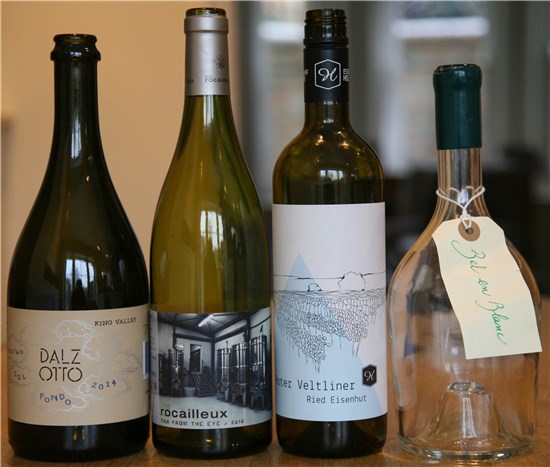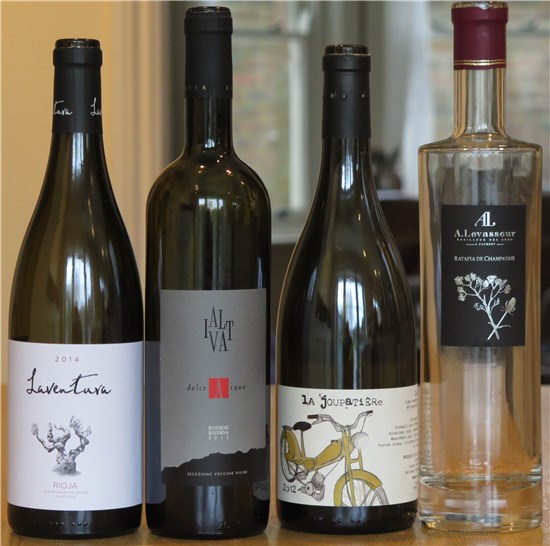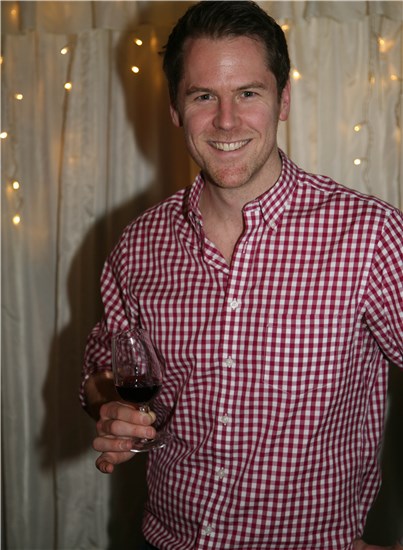 Nik Darlington made a welcome repeat visit to the Club on 27 February, bringing with him his personal selection from the Red Squirrel list. Nik has had a varied career, a political reporter, business consultant, scuba diving instructor and now wine merchant. He is driven by the determination not to allow the invading ‘grey squirrels’ (the standard ‘international’ grapes) to spread their tentacles and drive out the regional grapes that still cling to a spot in the world’s vineyard areas.
Nik Darlington made a welcome repeat visit to the Club on 27 February, bringing with him his personal selection from the Red Squirrel list. Nik has had a varied career, a political reporter, business consultant, scuba diving instructor and now wine merchant. He is driven by the determination not to allow the invading ‘grey squirrels’ (the standard ‘international’ grapes) to spread their tentacles and drive out the regional grapes that still cling to a spot in the world’s vineyard areas.
 We started the tasting on a very chilly night in the toasty-warmth of the welcoming Cherwell Boathouse Marquee with a very refreshing glass of the Dal Zotto family’s sparkling Col Fondo 2014. Yet another Prosecco? Far from it? This is made by Italians from the Prosecco grape – but in Australia’s King Valley, an Alpine region some hours to the north-east of Melbourne. Nik explained the background to an intriguing story. Fifteen years ago, before Prosecco started its decade-long boom, it was made from the Prosecco grape as a budget alternative of sorts to champagne. But, and this is the key point, ‘prosecco was the name of a grape. Hence it couldn’t be protected in the way that champagne is and has been for over a hundred years. So, the prosecco industry changed the name of the grape to Glera (a rarely used alternative name that had lingered on in a village somewhere in the Valdobbiadene district). What they forgot was that Italian emigrants had taken the prosecco grape to Australia. So, the Dal Zotto Pucino Col Fondo is the real thing: tank-made but bottled with the lees still in bottle under a crown cap. Hence the wine is cloudy, close to the colour of ginger beer and with a fascinating lemon cheesecake nose and a beautiful bitter finish. Dal Zotto’s prosecco is market leader in Australia and despite legal threats the Italian industry has failed to dislodge this really rather traditional challenger.
We started the tasting on a very chilly night in the toasty-warmth of the welcoming Cherwell Boathouse Marquee with a very refreshing glass of the Dal Zotto family’s sparkling Col Fondo 2014. Yet another Prosecco? Far from it? This is made by Italians from the Prosecco grape – but in Australia’s King Valley, an Alpine region some hours to the north-east of Melbourne. Nik explained the background to an intriguing story. Fifteen years ago, before Prosecco started its decade-long boom, it was made from the Prosecco grape as a budget alternative of sorts to champagne. But, and this is the key point, ‘prosecco was the name of a grape. Hence it couldn’t be protected in the way that champagne is and has been for over a hundred years. So, the prosecco industry changed the name of the grape to Glera (a rarely used alternative name that had lingered on in a village somewhere in the Valdobbiadene district). What they forgot was that Italian emigrants had taken the prosecco grape to Australia. So, the Dal Zotto Pucino Col Fondo is the real thing: tank-made but bottled with the lees still in bottle under a crown cap. Hence the wine is cloudy, close to the colour of ginger beer and with a fascinating lemon cheesecake nose and a beautiful bitter finish. Dal Zotto’s prosecco is market leader in Australia and despite legal threats the Italian industry has failed to dislodge this really rather traditional challenger.
The second wine was one of three still whites we tasted. This was the Clos Rocailleux ‘Far from the eye’ 2016. As members will know ‘Far from the Eye’ is the English translation of the French ‘Loin de l’Oeuil; (and the Occitan ‘Len de l’El’). Made by English couple in a village in ‘La France Profonde’ near Gaillac, the Loin de l’Oeuil is usually vinified as part of a blend with Mauzac but this is a single variety wine – just 800 bottles a year. The wine is pale yellowy white with a rich nose of grapefruit and pear – and a touch of something a bit creamier and a candied. Something like a blend of dry Semillon and Picpoul perhaps. This would be a brilliant food wine – either with richer fish dishes or with the local cuisine. Do go and visit them, said Nik. They’re fabulously welcoming.
The second of the whites was another rarity – a varietal wine made from Roter Veltliner. No relation of Gruner Veltliner, this is a pink-skinned grape made in tiny quantities in the Wagram area of Austria. The nose is rich and spicy (a hint of Gewurztraminer perhaps?) with citrus, tropical fruit and orange blossom. Dry (5-6g of residual sugar) but full and rounded in the mouth, this wine had bags of character and body but remains quite light at 12.5%. Definitely more versatile than Gewurz, this wine would pair perfectly with fish, white meats and rich pasta dishes.
Last of the three whites was another 100% varietal wine. This time we sampled Muscadelle made in a ‘solera style’ blending of several years production by Château de Bel. Bel en Blanc is necessarily a non-vintage wine and which (somehow and thankfully) hasn’t yet been banned by the Bordeaux authorities. Olivier Cazenave buys in white grapes from an organic farmer and produces this ‘Vin de France’ in a bottle shape of his own choice (close to Ruinart champagne), with a tied on label and an attitude that says ‘I make what I like!’. The result has the appearance and feel of a sweet wine but is bone-dry and (as a result of skin contact) a touch of tannin. Olivier gives Cab Franc similar treatment and there’s a Chenin Blanc / Riesling experiment on the stocks. As Nik noted, the Appellation Controlée system has secured heritage status and (more or less) ensured that little bad wine gets through the system – but this is at the expense of experimentation. Nik has very generously offered all members a 15% discount on these wines so do check out his website and see what you fancy to support diversity and bravery. It’s www.redsquirrelwine.com.
 We then moved over to the red wines – all of which went down very well with members. First up was the Laventura Rioja Tinto 2014. What’s new and rare about Rioja, I hear you ask? Well, a surprising amount in this case. The typical Rioja for the last century or so has been the warm climate wine of the lowlands ‘Rioja Baja’; rich tasting, lashings of vanilla and spice and quality measured solely by the number of years in oak. Not so the Laventura wine which is grown at 600-700 metres altitude, has a paler and brighter colour to it and loads of fresh fruit. Just a touch of oak but the aim is a dry wine with crisp tannins and flavours of black cherry (and a touch of blackcurrant leaf). Check out ‘Rioja ‘n’ Roll’, the loose group of friends and renegade wine makers who practise minimally invasive viticulture and do their own thing in the winery.
We then moved over to the red wines – all of which went down very well with members. First up was the Laventura Rioja Tinto 2014. What’s new and rare about Rioja, I hear you ask? Well, a surprising amount in this case. The typical Rioja for the last century or so has been the warm climate wine of the lowlands ‘Rioja Baja’; rich tasting, lashings of vanilla and spice and quality measured solely by the number of years in oak. Not so the Laventura wine which is grown at 600-700 metres altitude, has a paler and brighter colour to it and loads of fresh fruit. Just a touch of oak but the aim is a dry wine with crisp tannins and flavours of black cherry (and a touch of blackcurrant leaf). Check out ‘Rioja ‘n’ Roll’, the loose group of friends and renegade wine makers who practise minimally invasive viticulture and do their own thing in the winery.
Wine number 5 was, for many members, one of the stars of the evening. This was the Altavia Rossesse di Dolceacqua Superiore Riserva of 2012. Rossesse, grown in only a few inland spots on the Ligurian coast, is a real rarity. Nik knew the area and, as he put it, Rossesse was one of the reasons why he came to believe he had to set up Red Squirrel to give such wines a chance of survival. Rossesse is a clone of Tibouren (Provence by way of Greece) and there’s more than a touch of Pinot Nero’s elegance and freshness. The wine was pale garnet with a broad rim (another Pinot like quality) and we found loads of dry black fruit (blackcurrants and cherries) and white pepper with more than a touch of the minty nose that some compare to eucalyptus oil. Complex, more-ish and a long, harmonious finish.
 The final red was the Coline de l’Hirondelle ‘La Joupatière’ 2012. Seriously rare (only four cases left in the UK), seriously expensive and an extraordinary blend of thirteen named varieties (including every version /c colour of Pinot you can think of) and three unknown varieties. All from the same sandy field, all pre-phylloxera vines found in one of the oldest of all French vineyard areas near Corbières. This was another ‘Vin de France’ but the quality was closer to Grand Cru – dark, spicy, reminiscent of black treacle on the nose with great complexity and depth and a magnificent finish.
The final red was the Coline de l’Hirondelle ‘La Joupatière’ 2012. Seriously rare (only four cases left in the UK), seriously expensive and an extraordinary blend of thirteen named varieties (including every version /c colour of Pinot you can think of) and three unknown varieties. All from the same sandy field, all pre-phylloxera vines found in one of the oldest of all French vineyard areas near Corbières. This was another ‘Vin de France’ but the quality was closer to Grand Cru – dark, spicy, reminiscent of black treacle on the nose with great complexity and depth and a magnificent finish.
Last up was Champagne Levasseur’s ‘Ratafia de Champagne’. Finishing a tasting with champagne? Yes, indeed. For those who hadn’t come across it before, Ratafia is essentially a ‘stopped fermentation’ wine (a Vin Doux Naturel really). Made with champagne grapes, the resultant liqueur is a complex, powerful glass (18%) that can be taken neat with an ice cube as an aperitif, savoured with foie gras or sipped over Christmas pudding.
A fascinating tasting that delivered in spades on the Club’s ‘couldn’t taste wouldn’t taste’ mantra. Both those lucky enough to attend and those who couldn’t make it can benefit from a Club offer. Nik has generously offered us a 15% discount on the list prices – as well as a lifetime 5% discount on all Red Squirrel wines for ever. See the forthcoming offer sheet for details
GH: 3/3/2018